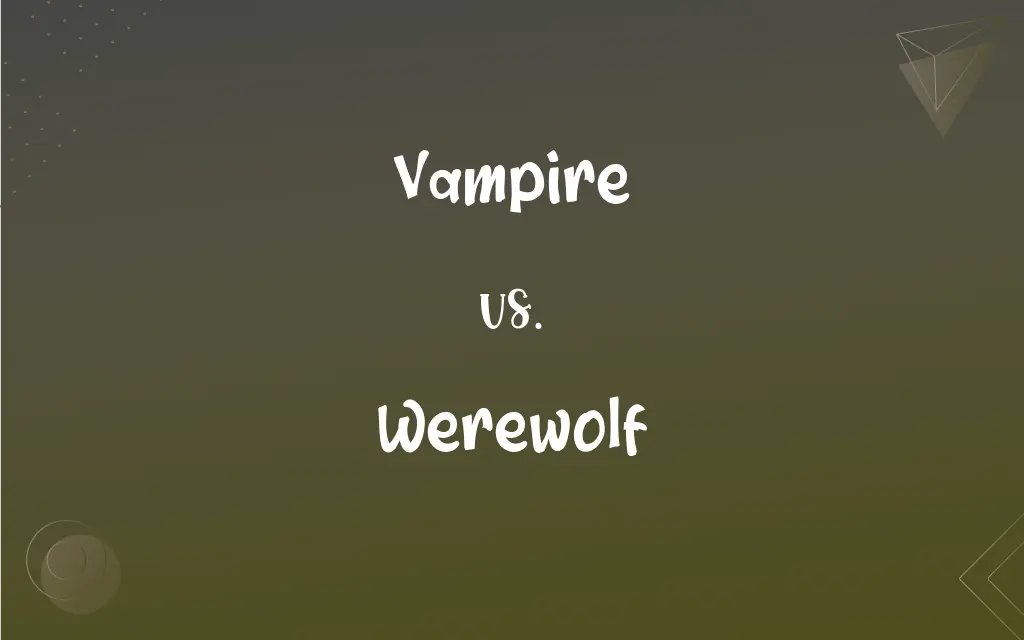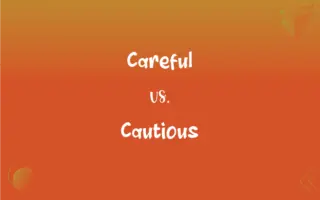Vampire vs. Werewolf: What's the Difference?
Edited by Aimie Carlson || By Harlon Moss || Updated on June 10, 2024
Vampires are mythical creatures that drink blood to survive and can have immortality, while werewolves are humans that transform into wolf-like creatures, typically during a full moon.

Key Differences
Vampires are often depicted as immortal beings who sustain their existence and powers through consuming human blood. On the other hand, werewolves are typically depicted as humans who transform into ferocious, wolf-like creatures, usually during a full moon. Both entities exist within their own contexts of horror and supernatural lore, engaging audiences with tales of fear, transformation, and occasionally, tragedy.
The mythology surrounding vampires often ties them to elements of seduction, allure, and a simultaneous fear of death and desire for immortality. In contrast, werewolves often embody themes of rage, loss of control, and the duality of human nature - the civilized being versus the wild creature. Here, both entities navigate through distinct yet equally captivating mythological terrains, tying them to the universal themes of desire, fear, and the unknown.
In literature and film, vampires frequently possess a sophisticated, enigmatic, and often aristocratic demeanor. Werewolves, when in their human form, might wrestle with their dual identity, facing moral and existential questions regarding their violent, uncontrollable transformations. Thus, vampires often become symbols of eternal, forbidden desire, whereas werewolves resonate with the struggle against our baser, more primal instincts.
In some stories, vampires can create other vampires by biting humans, thereby perpetuating their kind through a form of sinister procreation. Werewolves, in many tales, can also transform others into their kind through a bite or scratch, linking them to notions of contagion and the spreading of a cursed existence. Both creatures, therefore, intertwine with themes of propagation and the perpetuation of a cursed state through physical interaction.
Vampires and werewolves are often pitted against each other in various media, symbolizing a battle between different kinds of monsters, or metaphysically, varied aspects of humanity's fears and desires. While vampires seem to negotiate the human fear of death and the yearning for eternal life, werewolves mirror the struggle with the beast within, reflecting the dichotomous human condition of civility versus savagery.
ADVERTISEMENT
Comparison Chart
Origin
Often undead, coming back from the dead
Human transforming, often under a full moon
Transformation
Generally constant form, sometimes turns into a bat
Transforms during specific triggers, commonly a full moon
Propagation
Can create new vampires by biting humans
Can create new werewolves through bites or scratches
Common Weaknesses
Sunlight, garlic, holy symbols, wooden stakes
Silver bullets or objects, sometimes wolfsbane
Symbolism
Immortality, seduction, fear of death
Loss of control, primal instincts, inner conflict
ADVERTISEMENT
Vampire and Werewolf Definitions
Vampire
In many cultures, a vampire is seen as a seducer, using charm to entice its prey.
The vampire, with his mesmerizing gaze, lured the innocent into his dark embrace.
Werewolf
In mythology, a werewolf is sometimes viewed as a person cursed or infected in a way that triggers periodic, uncontrollable transformations into a wolf.
He lived as a recluse, safeguarding the village from his own monstrous alter-ego, the werewolf, which emerged under the lunar glow.
Vampire
A vampire is a mythical creature that drinks the blood of the living to maintain its existence.
The vampire stealthily approached its victim, ready to feast upon their blood.
Werewolf
Werewolves are often depicted as regular humans who, under specific conditions (such as a full moon), involuntarily transform into violent, wolf-like creatures.
The quiet village lived in fear, knowing that one of their own would become a werewolf when the moon was full.
Vampire
Vampires are often depicted as undead beings, having returned from death with a thirst for blood.
Despite being buried years ago, he arose as a vampire, haunting the night with an insatiable hunger.
Werewolf
A werewolf is a mythological or folkloric human with the ability to shapeshift into a wolf or therianthropic hybrid.
When the full moon rose, the man painfully transformed into a werewolf, howling into the night.
Vampire
Vampires are sometimes associated with immortality and eternal youth, which they attain through blood consumption.
Seeking eternal life, she willingly allowed the vampire to bite her, entering into an immortal existence.
Werewolf
Werewolves, in many stories, pass their curse to others via a bite or scratch, causing the victim to then also transform during certain lunar phases.
The woman, once bitten by the werewolf, braced herself for the agonizing transformation that awaited her.
Vampire
Vampires, in various tales, have the ability to transform into other creatures, such as bats, to travel or escape danger.
With a swift, fluid motion, the vampire transformed into a bat, disappearing into the inky night sky.
Werewolf
Within various cultural lore, werewolves symbolize the primal, savage nature that lies dormant within humanity, surfacing under particular circumstances.
Symbolizing unbridled rage and primal instincts, the werewolf tore through the countryside, embodying humanity's darker aspects.
Vampire
In popular folklore, an undead being in human form that survives by sucking the blood of living people, especially at night.
Werewolf
A person believed to have been transformed into a wolf or to be capable of assuming the form of a wolf.
Vampire
A person, such as an extortionist, who takes advantage of others, especially for personal gain.
Werewolf
(mythology) A person who is transformed or can transform into a wolf or a wolflike human, often said to transform during a full moon. Category:en:Horror
Werewolf
A person transformed into a wolf in form and appetite, either temporarily or permanently, whether by supernatural influences, by witchcraft, or voluntarily; a lycanthrope. Belief in werewolves, formerly general, is not now extinct.
The werwolf went about his prey.
The brutes that wear our form and face,The werewolves of the human race.
Werewolf
A monster able to change appearance from human to wolf
FAQs
What is a werewolf?
A werewolf is a person who transforms into a wolf or wolf-like creature, often during a full moon.
What is a vampire?
A vampire is a mythical creature that consumes the blood of the living to sustain itself, often depicted as undead.
What are common weaknesses of vampires?
Common weaknesses include sunlight, garlic, holy symbols, and wooden stakes.
How does one become a werewolf in most mythologies?
Commonly, one becomes a werewolf through a bite or scratch from another werewolf.
What time of the month are werewolves typically active in lore?
Werewolves are most commonly active and transform during a full moon.
Can vampires go out in daylight?
Traditional lore often prevents vampires from going out in daylight due to fatal weakness to sunlight.
What symbols are often associated with vampires?
Vampires are often associated with bats, coffins, and the night.
How can a person be cured from werewolf transformation?
Lore varies, but often a cure is complex and rare, sometimes involving killing the original werewolf.
How are vampires typically depicted in literature?
Vampires are often depicted as charismatic, intelligent, and somewhat aristocratic.
Are werewolves conscious or have self-control during their transformation?
In most lore, werewolves lack consciousness and control when transformed.
Do vampires have reflections?
In many myths, vampires do not have reflections and cannot be seen in mirrors.
Can vampires eat normal food?
In most lore, vampires do not consume traditional food and only draw sustenance from blood.
Can vampires and werewolves create others of their kind?
Yes, vampires typically create others through bites, and werewolves often through bites or scratches.
Can a vampire enter a home uninvited?
Traditional myths often state a vampire must be invited into a home before entering.
What is a werewolf's main weakness?
Traditionally, a werewolf’s weakness is often related to silver, such as silver bullets.
How is a vampire typically created in lore?
In many stories, a vampire is created by being bitten by another vampire.
Can a werewolf transform outside of a full moon in any mythology?
In some stories, werewolves can transform at will or under different triggers aside from the full moon.
Are all vampires immortal?
Immortality is a common trait associated with vampires in many cultural depictions.
Are werewolves inherently evil?
Depictions vary; some portray them as victims of a curse without malicious intent, while others depict them as malevolent.
Do werewolves remember their actions after transforming back?
Lore varies, but werewolves often do not remember their actions while transformed.
About Author
Written by
Harlon MossHarlon is a seasoned quality moderator and accomplished content writer for Difference Wiki. An alumnus of the prestigious University of California, he earned his degree in Computer Science. Leveraging his academic background, Harlon brings a meticulous and informed perspective to his work, ensuring content accuracy and excellence.
Edited by
Aimie CarlsonAimie Carlson, holding a master's degree in English literature, is a fervent English language enthusiast. She lends her writing talents to Difference Wiki, a prominent website that specializes in comparisons, offering readers insightful analyses that both captivate and inform.































































